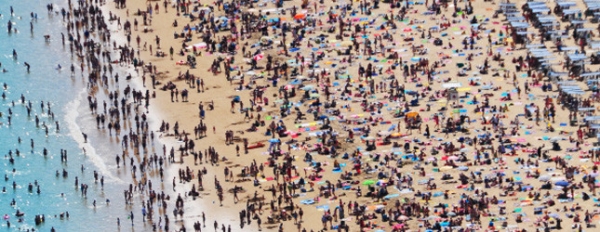Don't miss out on the best jobs!
Subscribe to HelpGoAbroad and weekly we will sent you an email with latest job posts. Provide your email address below
We all eagerly look forward to holiday time, when we get a break from work or school and get the chance to head off somewhere exotic. So when the time to get out of cold winter for the holiday season and head to more tropical locations, upon arrival you will quickly realize that you were not the only person who had an escape plan to Hawaii or Tahiti. Summer holidays are also a popular time for travel as families can head out together and enjoy vacationing abroad. These peak time frames of high travel are considered high season and from the alternative perspective of those working in the tourism industry, this is the time to really make some profit off oblivious tourists.
You could eternally chase summer or winter, heading around the world following favourable climates. The trick to timing your traveling seasonally is to head to desirable destinations during ‘shoulder season’. This is a period of time when the weather is near-perfect, rates are dropping and tourist hoards are far fewer than just a few weeks before, known as Shoulder Season.
Below are a few countries and their respective times to visit so that you get the most out of your experience abroad with the least out of your wallet.
Thailand
The beautiful country of Thailand experiences climates similar to the rest of South East Asia. The monsoon season or rainy season is from July to October, where heavy rains and intense weather patterns can seriously dampen your travel plans. Roads may be washed over, boats refrain from transporting people due to rough waters and whole islands shut down due to stormy weather. The dry season, or high season is between November and March, is a time when the tourist flock to the calm dry temperatures and lush landscapes thanks to the recent monsoons. Shoulder season thus falls from April-June and September-October, you will find that the earlier shoulder season is hot and dry but beaches are relatively uninhabited and ocean breezes keep you cool while the later seasons in September and October are better for heading up North to Chiang Mai and Pai.
France
Though it may not be the largest country in Europe, it still has climate diversity between the North and South, and between different regions by the coast or near the mountains. High season is caused by school holidays; summer in August brings several international tourists, all clambering for a photo with the Eiffel Towel or crowding up beaches while trying to keep cool on summer holidays in Biarritz. Come winter, the French Alp ski resorts booked several months in advance for vacations between December and March, as these are exceptionally popular months for travel. Low season kicks in when everyone has to return to school and work, and you will find prices reduced 50% less from what they were during busy season, availability of open museums, shops, and restaurants are reflected in shorter hours and days open. While low season still holds fair weather in the autumn month of October, Shoulder season is between April and June and September through December and you will see hotspots prices dropping and still have plenty to enjoy whether you go in spring and see the spring bloom, shining sun and fresh vegetables and fruits or in the autumn to enjoy the vendage or grape harvest.
Brazil
Since they receive travellers from all corners of the world, holiday seasons reach a bit longer than average since different countries have different school holidays. High season is considered December through March, when the northern-hemisphere weather drives people south to the sunny beaches and Carnaval brings locals from near and wide during February, as well as visitors to the major cities of Rio de Janiero, Salvador and Recife where celebrations have set world records with millions of people in attendance. However, different parts of the country have their own high seasons depending on the industry that drives the region. In the Northeast, Jericoacoara is a small tourist town that largely receives tourists due to its incredible kitesurfing and windsurfing conditions that are almost year round.
Japan
In the Northern temperature zone, Japan experiences all four seasons with variations in climate occurring between the North and South. Winter is popular time for travel to the Northern region of Hokkaido for some incredible skiing and snowboarding, while the subtropical southern islands such as Okinawa are a great escape during colder temperatures. Summers are very hot and humid, especially in cities like Tokyo, and June usually brings the rainy season that lasts for at least a few weeks. High season revolves around school and public holidays such as Golden Week at the end of April and heading into May, O-Bon, The Festival of the Dead, in the middle of August and Shogatsu, the New Year period. During these times, transportation reservations will be hard to come by on the fly, several crowds of both foreign and local travellers and numerous establishments shut down. Shoulder season is quite popular for foreign visitors who head to Japan to see the cherry blossom bloom that lasts for only a week in March and the autumn equivalent that occurs in October are uniquely beautiful and also bring pleasant weather. Japan is a beautiful country that despite certain climate extremes in winter and summer, travel at any time of the year to the right part of the country will be a noteworthy experience.
North America
North America has a diverse climate situation, as you can find sunshine at almost anytime of the year while at other times freezing winter conditions can be the foundation for a fantastic ski vacation. The Northwest region that includes notable cities like Seattle and Portland, faces dreary years full of grey skies and endless rain, but inhabitants are rewarded in the summer from July to the end of August and sometimes early September, when the air is not too humid, there is a cooling breeze and the sun is shining- perfect outdoor adventure weather. Just south is California, where sunshine and warmth grace the region almost all year long. California gets very busy during the school holidays of June-August and December-January, as you can enjoy the beach during the summer and skiing in Lake Tahoe during the winter. The Midwest climate varies depending on how north or south you are and there aren’t as many tourists heading to these parts as compared to the more coastal states. The Northeast is rather humid in the summer and experience very cold winters, but they have visually spectacular autumn seasons. The Southeast boasts warmer climates the further south you travel, so states such as North Carolina, have mild climates that reflect four seasons while Florida has more tropical conditions that have a dry season from November to April and the remaining time is wet with hurricanes that peak in September.
Africa
Given Africa’s enormous size and equatorial location, each region of Africa has a bit of a different climate. North African temperatures can be excruciating and the best time to head over would be during the cooler months between October and March. East Africa has rainy and dry seasons, with the dry seasons occurring between December to February and March to June, and rainy season fills in the months between. Southern Africa has rainy season from November to about May, a dry season that begins in May and peaks around October when temperatures are exceptionally hot. West Africa has dry season in October to May, with heat waves swelling near the end of the dry period.
Although wet season usually constitutes ‘do not travel’ periods, the fact is that just because it’s rainy season it’s going to rain all day long. Rainy season rain can sometimes last for a few short minutes or maximum an hour or two, in some areas it usually rains during the night so you can wake up to rain-kissed sunshine. However, in some areas, rainy season can be responsible for overflowing rivers and flooding dirt roads, turning them into mud. Although rainy season should not be avoided, you should take care when and where you travel during risky times of the year. If you rely on dry season for perfect weather, just be sure to time it for when the heat isn’t at it’s strongest. There are so many different parts of Africa to explore, such as the Saharan area, which is great between November and February, which will bring nightly cold conditions, and the ever-popular safaris will be booming with wildlife in North Africa between March and May.
Sign in to publish a comment





Be the first to comment on this post.